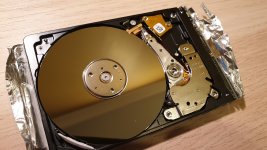Hello all,
I'm new to the forum and need help with trying to recover data on my portable HD that was dropped into carpet from about less than 2ft height.
The HD was making low clicking noise and not reading. So I assumed that it was the heads not reading.
I have very sensitive data on the HD, hence I can't bring it to a professional. I am a noob, and have never done this before. But based on watching YouTube videos, I tried to attempt the clear the jammed head myself. I've done everything right, open the case, carefully moved the head back into place by rotating the platter. Everything was done right and in my opinion, to perfection. Not in clean room of course. But the platter looks to be in perfect shape, no scratches or marks whatsoever.
After putting the head back to where it's supposed to be positioned and closing the case. The HD now makes a beeping sound, and still doesn't read.
So my questions to all you experts:
1) what is the beeping sound likely to be?
2) could it be magnetized together head readers?
3) if I was to use a donor drive, could I move the platter to the donor drive and make it work? (not in a clean room of course)
Really appreciate it if anyone can shed some light on what would be the best method for me to recover the data without seeking a professional.
Thank you!
Landon
I'm new to the forum and need help with trying to recover data on my portable HD that was dropped into carpet from about less than 2ft height.
The HD was making low clicking noise and not reading. So I assumed that it was the heads not reading.
I have very sensitive data on the HD, hence I can't bring it to a professional. I am a noob, and have never done this before. But based on watching YouTube videos, I tried to attempt the clear the jammed head myself. I've done everything right, open the case, carefully moved the head back into place by rotating the platter. Everything was done right and in my opinion, to perfection. Not in clean room of course. But the platter looks to be in perfect shape, no scratches or marks whatsoever.
After putting the head back to where it's supposed to be positioned and closing the case. The HD now makes a beeping sound, and still doesn't read.
So my questions to all you experts:
1) what is the beeping sound likely to be?
2) could it be magnetized together head readers?
3) if I was to use a donor drive, could I move the platter to the donor drive and make it work? (not in a clean room of course)
Really appreciate it if anyone can shed some light on what would be the best method for me to recover the data without seeking a professional.
Thank you!
Landon

